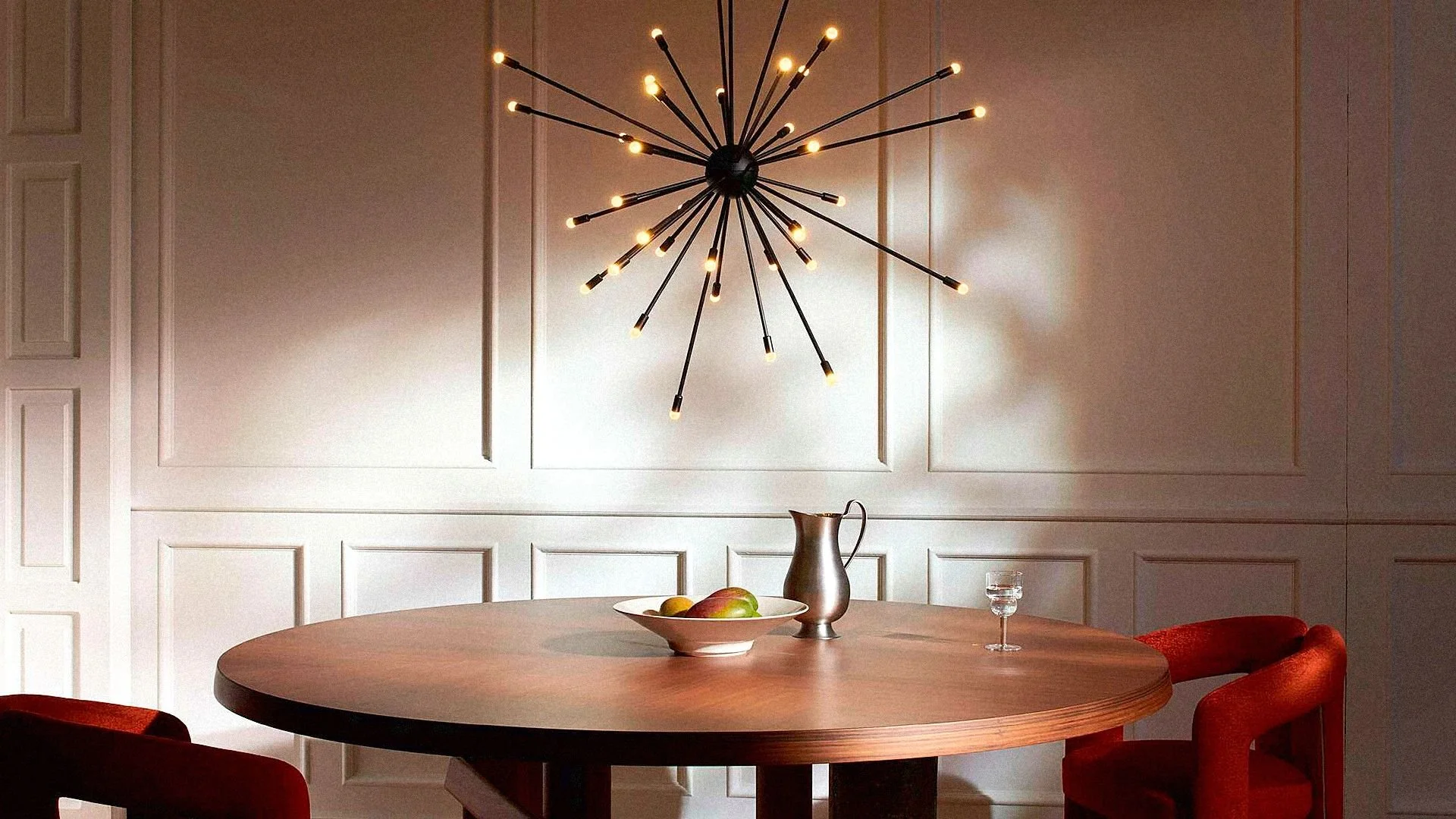While Charles and Ray Eames are renowned for their comprehensive design portfolio, their lighting designs represent a lesser-known yet significant aspect of their work.
In 1949, the distinguished design duo created a remarkable prototype called Galaxy for the Exhibition for Modern Living in Detroit. This innovative piece, crafted from a wooden croquet ball and precisely measured brass tubes in a starburst configuration, garnered significant attention from influential architects Marcel Breuer and Philip Johnson. However, due to their concurrent development of the groundbreaking Plastic Molded Chair, the Galaxy lamp project was temporarily set aside.
Currently, the Galaxy light is making its commercial debut at $4,040, accompanied by the Helena suspension lamp ($785), which Charles designed in 1934 prior to his collaboration with Ray for a church in Helena, Arkansas. Following their successful introduction at Milan's Salone del Mobile, both pieces are now available in the U.S. market, initiating an expanding lighting collection. According to Eames Demetrios, director of the Eames Office, chairman of the Eames Foundation, and grandson of Charles and Ray Eames, "This lighting collection presents an exceptional opportunity to illuminate another dimension of the Eames legacy."
From prototype to mass-production
The development of both Helena and Galaxy emerged from a collaborative effort between the Eames Office, Italian furniture manufacturer Cassina, and design firm Form Portfolios, which specializes in preserving and advancing design heritage. The contemporary Galaxy features a central sphere with 36 radiating stems, available in sophisticated matte black or polished aluminium finishes. The Helena incorporates a blown glass sphere, complemented by an aluminium hemisphere adorned with delicate star perforations and an elegant orbital ring that serves as a decorative element.
Subscribe to the Design newsletter.The latest innovations in design brought to you every weekday
These releases mark the inaugural mass production of Eames lighting designs. The Galaxy lamp's transition from prototype to production presented unique challenges, as no scaled drawings existed. Fortunately, the original itemized specifications of the rays' dimensions, preserved due to Johnson and Breuer's interest, provided crucial reference points. Combined with archival exhibition photographs, these specifications enabled the development team to create precise computer models for manufacturing.
The Helena lamp's development process involved meticulous documentation of the original installation at St. Mary church in Arkansas, including comprehensive photographic documentation and precise measurements. While the development process spanned 18 months from inception to market release, the underlying narrative, as Demetrios notes, extends far deeper into history.
'The story of light'
The Eames House stands as a testament to Charles and Ray Eames's masterful understanding of illumination. "Their approach to design was inherently comprehensive," Demetrios explains, noting that Charles's expertise in lighting began during his early career at Guth Lighting and his studies in stained glass craftsmanship in St Louis.
Upon assuming leadership of the Eames Office following Ray's passing in 1988 (Charles had preceded her by exactly a decade), Demetrios embarked on an extensive research initiative, conducting 200 hours of interviews with former office staff members. His 1991 visit to the Helena church yielded particularly meaningful insights when the builders' children highlighted the intentional design of the lights, which created a celestial experience - revealing stars during the approach to the altar and transforming into a sun-like orb upon departure. "This discovery was particularly significant," he reflects, "and prompted consideration of how to properly showcase this aspect of their work."
A 'prequel' to the Eames story
The journey to bring these designs to market required patience and persistence. Despite the Eames Office's established relationships with Vitra and Herman Miller (now Miller Knoll), these traditional partners determined the lighting projects weren't aligned with their current objectives, as Demetrios explains.
Form emerged as the ideal partner for this initiative. Founded in 2016, the design firm focuses on preserving and extending the influence of both historical and contemporary designers. Mark Masiello, the firm's founder, draws an insightful parallel between Form's mission and music publishing, explaining their role in managing, promoting, and licensing designers' intellectual property. "My extensive background in design led me to recognize the parallel between design rights and music rights," he elaborates. "While both are protected under identical copyright laws, design lacks the robust protection infrastructure that exists in the music industry."
advertisement
Masiello envisions Form's role as similar to what the film Bohemian Rhapsody accomplished for Queen - introducing iconic creative work to a new generation. "My teenage stepson developed a profound appreciation for Queen through that film," he notes.
In the context of Eames, Masiello views these lighting pieces as essential components of the broader Eames narrative - elements that contribute to a more comprehensive understanding of their design philosophy. Form's introduction of the Eames Office to Cassina proved fortuitous, and despite the Eames's historical exclusivity with Vitra and Herman Miller, all parties united behind the principle that exceptional design should be widely accessible.
A new definition of authenticity
Regarding his grandparents' potential response to the widespread availability of their lighting designs, Demetrios expresses confidence in their approval of contemporary adaptations. For instance, Cassina's implementation of a modular "plug and play" system for the Galaxy, allowing individual rod insertion into the sphere, represents an innovative solution for efficient shipping logistics.
While traditionalists might question the authenticity of modifications like removable rods, which weren't specified in the original design, Demetrios emphasizes that authenticity lies in honoring the fundamental principles rather than exact replication. He references the Eameses' own ten-minute film showcasing their Sofa Compact's innovative flat-pack design as evidence of their commitment to practical solutions. "Contemporary adaptations are appropriate when they preserve the integrity of the original design," he maintains.
This philosophy extends to other recent initiatives, such as the reintroduction of their celebrated plywood elephants($2,400) in a new plastic version ($430), and the adaptation of the iconic Eames Molded Plastic Chair to incorporate post-consumer materials. "The Eames Office retains all intellectual property rights, and we've been entrusted with exercising our best judgment," Demetrios explains. "Our mandate is clear: preserve both the physical legacy and the design principles, and that remains our unwavering focus."

